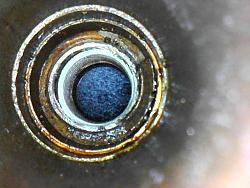Hi Guys,
I'm wondering if anyone out there has a good method of removing worn out or stripped helicoils that are down inside a deep hole, typically deeper than 4 times the dia, where you can't get a pair of pointy nosed pliers into the hole to extract the offender..
The method I currently use, and is by far the quickest one I have found so far, is to use a small dia long tapered drift with about a 3mm dia end ground to a chisel point and a flat blade 8mm screwdriver with a slot ground into the side of the head with a 1mm cutoff blade from an angle grinder and at a small angle to act as a hook. The screwdriver is still usable as a screwdriver.
I use the drift to pop out one side of the Helicoil so you have a little tail projecting out into the hole and then use the slot in the screwdriver head to slip over the "tail" of the Helicoil you just freed and pull out the worn or broken piece. Usually takes about 30 secs from start to finish.
How do your methods stack up? I would be interested to find a better method.
My current field is underground mining equipment and a lot of the stuff I work on is helicoiled Aluminium parts.
Richard.


 LinkBack URL
LinkBack URL About LinkBacks
About LinkBacks


 Reply With Quote
Reply With Quote



Bookmarks